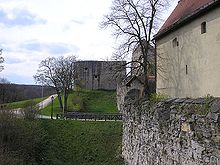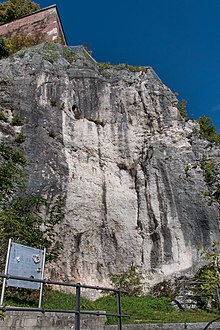Hellenstein Castle
The Bright Stone Castle is one above the city of Heidenheim an der Brenz located fortress . It was once the headquarters of the von Hellenstein family. The ownership changed later: in the late Middle Ages the facility was in Bavarian hands, at the beginning of the modern era it was owned by Württemberg.
history

In 1096 the construction of the Staufer building began by Gozpert de Halenstein , whose grandson Tegenhardus de Haelenstein , also Degenhard von Hellenstein , was a follower of the Hohenstaufen emperor Friedrich I Barbarossa . Degenhard expanded the castle significantly. Numerous humpback cubes in the walls of the knight's hall can be assigned to this phase. The rule of the Hellensteiners ended in 1273. After that, the castle changed hands several times. From 1351 to 1448 the Counts of Helfenstein owned the castle. After 1450 the castle came into Bavarian ownership .
In 1503 the castle came under the government of the House of Württemberg as the center of the Heidenheim rule . On August 5, 1530, it burned down to the foundation walls, the reconstruction by Duke Ulrich von Württemberg took place in the years 1537 to 1544. When Duke Friedrich I of Württemberg came to power in 1593 , he decided to build a castle to the east of the medieval castle. Master builder Heinrich Schickhardt received the planning order in 1598 . The castle area was enlarged by towers and bastions and a castle church in Renaissance style was built as a transverse church by Schickhardt's colleague Elias Gunzenhäuser, based on the model of the castle church in Stuttgart's old castle . It has long since been de-dedicated and profaned as a church and has housed a municipal museum since 1901. Two towers with richly decorated columns and coats of arms formed the entrance. Towards the city they were flanked by gun turrets.
The castle had become a handsome princely seat and housed guests in its walls, including Wallenstein (1630), Eugen von Savoyen (1702) and Karl von Österreich-Teschen (1796).
Kindlesbrunnen
In the southern part of the castle is the Brunnengärtle with its 78 meter deep “ Kindlesbrunnen ”. This is so because the Heidenheim babies are not brought by the stork, but - according to a legend - are brought out of here.
The castle fountain was dug from 1666 to 1670 by Königsbronn miners. A very expensive and complex company that cost around 6,750 guilders (roughly € 500,000 based on today's purchasing power). The water supply had to be secured again because the previous complex pipe system designed by the innovative builder Elias Gunzenhäuser had been destroyed in the Thirty Years War . This had supplied the castle from the fountain mill spring 80 meters below .
Slow termination
The original castle lost its importance. From around 1762 the ducal camera administration did not spend any more money on the renovation. The complex fell into ruin and was finally released for demolition in 1797. In 1810 the upper storey of the battery tower (round tower) was removed. Wall and ceiling paintings by the Bavarian court painter Friedrich Sustris were lost. In 1593 he was personally commissioned by Friedrich I of Württemberg to paint the hall on the upper floor. In 1820 the Ministry of Finance even approved the sale and demolition of the roof and the installation of the old mountain castle. Parts of the castle that belonged to the ducal building trade and the step-shaped, stone gables of the keep were left standing because of the view. When the Völter paper mill burned down a year later, stones and timber were taken from here - with permission - for reconstruction. Over time, stone by stone, the original humpback cuboid from the Hohenstaufen era and the richly ornamented top of the south portal disappeared. In 1837 the royal building authorities finally forbade breaking further stones out of the walls.
Pagan forge
The Heidenschmiede is an abri in the south-eastern limestone rock massif on which Hellenstein Castle was built. After its recent discovery by Hermann Mohn in 1928, the Abri turned out to be an important Middle Paleolithic site of prehistory in Baden-Württemberg . The Heidenschmiede was therefore visited by Neanderthals around 70,000 to 50,000 years ago in the Jung-Acheuléen , who presumably only stayed there briefly to manufacture tools . In honor of the explorer Hermann Mohn, the Hermann-Mohn-Weg has been leading from the former home of the Mohn family in Schlossstrasse via the Zwetschgagärtle to Hellenstein Castle and the Heidenschmiede since 1990 .
The museums
Local museum
In 1901 the Heimatmuseum des Heimat- und Altertumsverein was opened in the former castle church, but a year earlier the collection of local and cultural-historical objects was exhibited there. Prof. Eugen Gaus , who founded the Heimat- und Altertumsverein, enriched this museum with many of his own excavation finds.
When Alfred Meebold donated his Indian collection , the premises had to be expanded. The Obervogteisaal, the upper tower room, the coach house and the cellar became part of the local history museum. From 1956 to 1960 the museum was redesigned in three stages. On the occasion of its 75th anniversary, the Heimat- und Altertumsverein again invested a lot of money in the expansion and furnishing of the former armory.
State Museum
Between 1982 and 1986 the city of Heidenheim had the fruit box renovated and in 1987 opened the Museum for Carriages, Chaises, Carts , a branch museum of the Württemberg State Museum . It offers a comprehensive overview of traffic developments over the past two hundred years.
The knight's hall as an opera stage
After it became known that various minstrels sang in the castle in the Middle Ages, the place has been used for cultural purposes again since 1964. In the ruins of the knight's hall of Hellenstein Castle, the open-air performances of the Heidenheim Opera Festival take place every year, followed by the youth musical project JuMP, which has existed since 1998. They emerged from the earlier castle serenades. There are also guided tours through the city and castle.
Broadcasting system of the Südwestrundfunk
There is also a transmitter for Südwestrundfunk at Hellenstein Castle. The following programs are broadcast via this
| program | Frequency (MHz) |
RDS PS | RDS PI |
ERP (kW) |
|---|---|---|---|---|
| SWR1 Baden-Württemberg | 87.6 | SWR1_BW_ | D301 | 0.01 |
| SWR4 Baden-Württemberg - Schwaben Radio | 89.8 | SWR4_UL_ | DE04 | 0.01 |
| SWR3 | 97.6 | __SWR3__ | D3A3 | 0.01 |
| SWR2 - Reg. Baden-Württemberg | 99.1 | __SWR2__ | D3A2 | 0.01 |
Until November 1993, a medium wave transmitter was operated at Hellenstein Castle on the frequency 1413 kHz with 100 watts of transmission power.
photos
Humpback cuboid on the western wall of the inner castle
literature
- Günter Schmitt : Castle Guide Swabian Alb, Volume 6 - Ostalb: Hiking and discovering between Ulm, Aalen and Donauwörth . Biberacher Verlagsdruckerei, Biberach an der Riß 1995, ISBN 3-924489-74-2 , pp. 275-294.
Individual evidence
- ↑ Christoph Seeger: “It doesn't always have to be Schickhardt!” On the importance of Heinrich Schickhardt for church building in Württemberg at the beginning of the 17th century ; in: Robert Kretzschmar (ed.): New research on Heinrich Schickhardt . (Publications of the Commission for Historical Regional Studies in Baden-Württemberg B 151), Stuttgart 2002, pp. 111–143
Web links
Coordinates: 48 ° 40 ′ 33 ″ N , 10 ° 8 ′ 54 ″ E




















